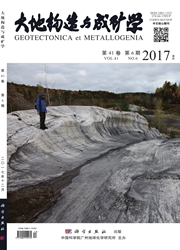

 中文摘要:
中文摘要:
垦丁混杂岩出露于台湾南部恒春半岛中新世增生楔内,长约20 km,宽最大可达1 km,呈北西-南东向狭长带状分布,大致平行于马尼拉海沟北段,其分布特征类似于与俯冲板块边界相关混杂岩的特征,因此垦丁混杂岩成因的确定对于了解台湾造山带结构及构造演化历史具有重要意义。关于垦丁混杂岩成因,目前主要分为沉积(olistostrome)成因和构造成因两大观点。通过野外观察,垦丁混杂岩的泥质基质普遍发生强烈的剪裂作用,鳞片状结构大量发育,基性或超基性的外来岩块夹杂其中。此外,在垦丁混杂岩内还发现香肠化的砂岩块、由泥质基质充填的脉体及砂岩表面的水压破裂等构造现象。这些现象均反映垦丁混杂岩为构造成因而非沉积成因。垦丁混杂岩体原形成于增生楔底部,并受到一定的高压及应力剪切作用,之后随同卷入的外来岩块及连续沉积地层块体一起沿着马尾逆断层出露于地表浅部,代表南海洋壳向东俯冲于菲律宾海板块之下形成的构造混杂堆积岩体。
 英文摘要:
英文摘要:
The Kenting Mélange located in the Central Range-Hengchun Peninsula accretionary prism shows a chaotic block-in-matrix structure. It was considered to be mainly of sedimentary origin (olistostromes) in the early 1990s, but tectonic origin gradually becomes a mainstream point of view when a large number of marine data has been collected since 1990s. According to lots of field observation, we find these chaotic deposits consist of a variety of blocks, up to km in size, of different lithologies such as chrome-spinel, gabbros, basalt and sandstones. These blocks float in a muddy matrix commonly showing a pervasive scaly foliation. Moreover, sausage-shaped sandstone, mud veins intruded in the exotic blocks under high pressure and heterogeneous hydrofracture in the surface of sandstones can demonstrate the Kenting Mélange was a tectonic origin rather than olistostromes. The Kenting Mélange can be considered as a mega-sheared fault zone about 1 km wide and 20 km long that approximately parallel to the north part of Manila trench, it is the character of tectonic mélange as fault rock of subduction plate boundary. In comparing the Kenting Mélange with the famous tectonic mélange in the world such as the Mugi Mélange in the Shimento Belt, Japan and the Bobonaro Mélange in the western Banda orogen, Indonesia, it is interesting to note the similarities. Moreover, seismic reflection profiles and foraminifera analysis studied before can also support the tectonic origin. In summary, a hypothesis can be proposed that the Kenting Mélange is a tectonic mélange as fault rock of subduction plate boundary at the front of the Taiwan accretionary prism, it formed mostly at the base of the accretionary prism by stratal detachment and fluid-assisted remobilization above a basal decollement, and then exposed through the splay fault system along with the involvement of the exotic blocks and the original continuous sedimentary strata block. The Kenting Mélange represents fault rock of subduction plate boundary during the subd
 同期刊论文项目
同期刊论文项目
 同项目期刊论文
同项目期刊论文
 Significance of indigenous Eocene larger foraminifera Discocyclina dispansa in Western Foothills, Ce
Significance of indigenous Eocene larger foraminifera Discocyclina dispansa in Western Foothills, Ce Depleted deep South China Sea δ13C paleoceanographic events in response to tectonic evolution in Tai
Depleted deep South China Sea δ13C paleoceanographic events in response to tectonic evolution in Tai The first record of Eocene tuff in a Paleogene rift basin near Nantou, Western Foothills, central Ta
The first record of Eocene tuff in a Paleogene rift basin near Nantou, Western Foothills, central Ta Tectonics, topography, and river system transition in East Tibet: Insights from the sedimentary reco
Tectonics, topography, and river system transition in East Tibet: Insights from the sedimentary reco Provenance analysis of the Miocene accretionary prism of the Hengchun Peninsula, southern Taiwan, an
Provenance analysis of the Miocene accretionary prism of the Hengchun Peninsula, southern Taiwan, an Cenozoic stratigraphy of Taiwan: Window into rifting, stratigraphy and paleoceanography of South Chi
Cenozoic stratigraphy of Taiwan: Window into rifting, stratigraphy and paleoceanography of South Chi 期刊信息
期刊信息
